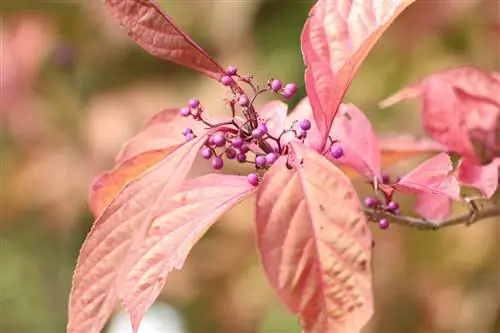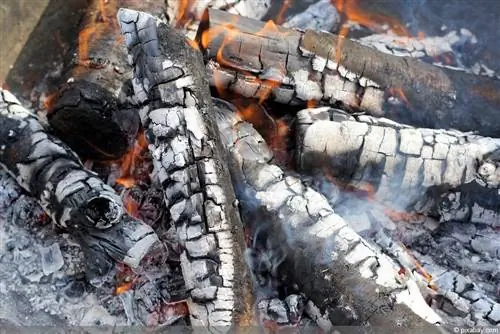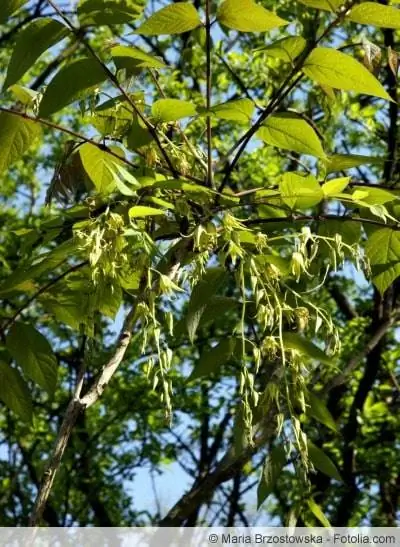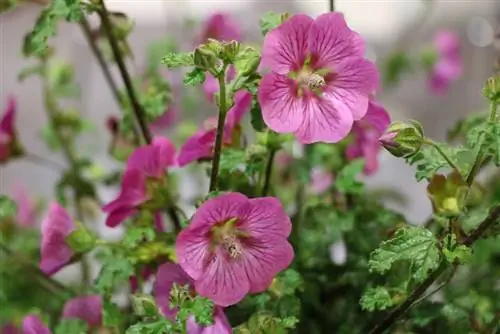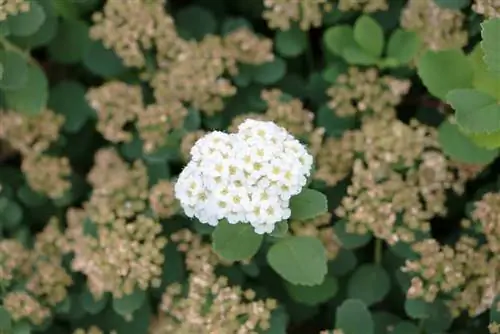- Author admin [email protected].
- Public 2023-12-17 03:39.
- Last modified 2025-01-24 12:45.
The love pearl bush (Callicarpa giraldii) - also known as purple beautiful fruit, Chinese beautiful fruit or simply just beautiful fruit - belongs to the mint family. It is an ornamental plant, produces shiny, purple berries in autumn and originally comes from China. There are approximately one hundred and forty related species worldwide. In Germany it is very popular with hobby gardeners due to its easy handling and beautiful coloring in autumn.
Plant correctly
- When: Spring or Autumn
- Location: shady or semi-shady
- Soil properties: low in lime, light and well-drained
It is best to plant several bushes so that they can pollinate each other and subsequently produce more fruits and berries. In this way you can also create a beautiful privacy screen that can be between two and three meters high. However, care should be taken to ensure that the individual beautiful fruits are planted at a distance of 80 cm to ensure that each individual plant is well supplied.
Tip:
Loose the soil with coarse sand to improve permeability.
Protection and care
The older a pearl bush is, the more likely it is to be described as hardy. Young plants are particularly susceptible to frost. They should be protected in winter. Commercially available helpers such as jute and fleece bags are suitable for this, or you can place fir branches on the bushes and tie them tightly. The roots should be protected with bark mulch and the beautiful fruits should not be fertilized. So far there are no known pests or diseases from which the shrub needs to be protected. S alting in its immediate surroundings should be avoided, as this can cause leaf damage. If the beautiful fruit is in the front garden, the driveway and sidewalk should be kept free of ice and snow, if possible without the help of s alt. Even years later, these s alts seeped into the soil can cause damage to plants.
Tip:
If drought persists, water the pearl bush with collected rainwater, as this is almost lime-free.
Cut
The love pearl bush bears its berries on two-year-old wood. This means that you should think carefully before cutting whether it is necessary. There is nothing wrong with cutting out one or two branches with the help of a sharp knife for decoration. A shrub can also cope well with cutting out branches with few flowers over the summer. In general, however, you should leave the branches untouched so that the berry growth is nice and dense the following year.
The exception is beautiful fruits that have already grown very large and are bald from bottom to top. Here the shrub should receive a comprehensive pruning in the spring. Although only a few berries and flowers can be expected in autumn, you can expect colorful splendor again the following year.
Propagation
If you want to increase your existing stock of beautiful fruit, there are two methods. You can either propagate your plants by sowing or by cuttings. The latter is the simpler method, but it denies the hobby gardener the feeling of having created a new life with his own hands.
It is advisable to have a few things ready when sowing:
- a bowl
- a container for cultivation (flower pot with holes)
- Growing and culture substrate
- some sand
- some pebbles or granules
- Clear film
- a rubber band
So equipped, sowing is possible all year round at a temperature of at least 20 °C.
- The seeds are first soaked in a bowl of lukewarm water for 24 hours.
- Sand and growing substrate are mixed, a thin layer of pebbles or granules is poured into the growing container and the container is filled with the mixture.
- The seeds are inserted in such a way that there is space for the seed to be approximately twice its length at the top.
- The mixture is moistened, everything is wrapped in cling film and tied together with a rubber band.
- It is advisable to make a few holes in the film, otherwise mold could form under the film due to the high humidity.
The film can be removed again two to three weeks later. The seeds now germinate and have to find their way to the light on their own. If the first leaves are visible, the seeds can be pricked out. This refers to the transplanting of seeds at larger distances. It is best to get your own pot that has previously been filled with growing medium.
As long as the temperatures allow it, the small plants can develop outdoors. If the first cold weather is approaching, they should be given a frost-proof place in a protected location for at least the first two years. As the shrub grows larger, it will need to be repotted into larger and larger containers over time until it is finally strong enough to find its way into the garden. If you want to propagate your love pearl bushes through cuttings, you should do this in autumn. This requires significantly less equipment:
- a sharp knife
- a cultivation container
- Substrate
This is the safest way to propagate using cuttings:
- Cut off long, he althy shoots close to the ground
- Cut the shoots with a sharp knife. There should be buds on both the top and bottom.
- The cuttings are now placed in groups of three or four into suitable cultivation containers so deep that they only protrude two centimeters. The cultivation container itself should be filled with substrate.
- The vessels are then placed in a frost-free, cool place and moistened regularly.
The containers will be put outside next spring. By summer, sufficiently large roots should have formed that allow the cuttings to be pricked out and then planted in the garden. If this is not the case, it is better to wait until next spring to plant the cuttings in the garden. Of course, you can also plant the cut cuttings straight into the ground. The chances of this approach being successful are extremely dependent on the weather and are therefore significantly worse than rearing in a container that can be brought to safety in an emergency.
Tip:
To ensure that the substrate is germ-free, you can put it in the oven at 200 °C for 20 minutes. But please let it cool down again before planting!
Frequently asked questions
Can you eat the purple fruits of the beautiful fruit?
The fruits are usually poisonous. Only the variety 'Callicarpa americana' is exceptionally edible. That's why you should find out exactly which beautiful fruit you are dealing with before tasting it.
Which plants make good neighbors?
Mock hazel or hazelnut are recommended here. Like the love pearl bushes, they are particularly beautiful to look at in autumn thanks to their colors.
What you should know about the pearl bush in brief
Profile
- The love pearl bush (Callicarpa) is also called the beautiful fruit because of its eye-catching fruits.
- It is a beautiful decoration for the garden, especially in autumn and winter, because then a multitude of round purple fruits are formed.
- The love pearl bush is about two to three meters high and about the same width and can therefore also be cultivated in a pot.
- It is a deciduous shrub that sheds its leaves in autumn, but before then they change color to very beautiful shades of yellow, orange and red.
- This shrub produces its flowers in midsummer, usually from July to August. They are not particularly conspicuous, but attract many bees and other insects.
- The spherical fruits that form later are very beautiful. They are purple and shiny and often remain on the bush until winter.
- These fruit-covered branches can also be cut from the bush to use as decoration for the home.
Propagate
Love pearl bushes are self-pollinating, but if you value a particularly large number of berries, you should plant several bushes so that they fertilize each other. However, these berries are somewhat dangerous for small children because they are poisonous.
Plants
- A love pearl bush needs a sunny to partially shaded place. It is best suited to mild locations where it doesn't get quite as cold in winter.
- But even there it should be somewhat protected, for example near the wall of the house.
- A layer of bark mulch spread around the trunk protects its roots from the cold in winter and from drying out in summer.
- Otherwise, the ground around the plant can also be covered with a thick layer of leaves or pine branches in winter.
- The love pearl bush thrives in almost any soil, but it shouldn't be too calcareous. It should also be well drained.
- If the drought lasts for a long time, the plant needs to be watered every now and then so that the soil does not dry out completely.
- The love pearl bush is best planted in autumn or spring, when it has become a little warmer.
Cutting
- A love pearl bush should be cut as little as possible. If it gets too big, its branches can be shortened a little or the bush as a whole can be thinned out a little.
- Twigs on which hardly any berries are forming can also be pruned so that new shoots form again and the bush as a whole rejuvenates.
- Smaller pruning measures can be carried out all year round, but early spring is better for heavy pruning.
- Then dead shoots can also be removed straight away, because in a cold winter the bush may freeze back a little.

